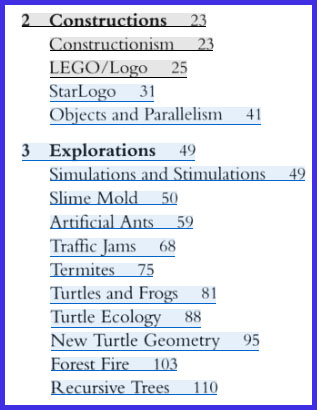
www.amazon.com link to textbook: Turtles, Termites, and Traffic Jams by Mitchel Resnick. NOTE: Use Search inside this book link to read pages 3 through 8 (First Pages) of the book, if you do NOT have it yet.
Read pages 3-8 of the book (23 paragraphs). You can read these pages on the amazon.com link if you do not yet have the book. LOOK INSIDE the book and choose FIRST PAGES.
For your convenience, I have provided the first sentence of each and every one of the pargraphs here. Makes a good outline and study guide to help your focus and note taking and the future discussion.
Chapter 1 - Pages 3 through 8 - first sentence of each paragraph.
These 23 paragraphs and these 6 pages are available in the amazon First
Pages preview LOOK INSIDE! this book.
------------ Click to LOOK INSIDE!
1 ---------------------
--------------------------------
Foundations
Any study which throws light upon the nature of "order" or "pattern"
in the universe is surely notrivial.
---Gregory Bateson, Steps to an Ecology of Mind
A flock of birds sweeps across the sky.
Like a well-choreographed dance troupe,
the birds veer to the left in unison.
Then, suddenly, they all dart to the right
and swoop down toward the ground.
...
How do birds keep their movements so orderly, so synchronized?
...
Bird flocks are not the only things that work that way.
...
In recent years, there has been a growing fascination with these types of systems.
...
Almost everywhere you look these days, there is evidence of decentralization.
... ----------------
But even as the influence of decentralized ideas grows,
there is a deep-seated resistance to such ideas.
...
This assumption of centralized control, a phenomenon I call the
centralized mindset, is not just a misconception of the scientifically naive.
...
Of course, centralized ideas are not always bad or wrong.
...
That is starting to change, but only slowly. There is a powerful tension.
...
In this book I explore both the allure of decentralization and
the centralized mindset that resists it.
...
My investigation consists of several interwoven threads, each of which
reinforces and enriches the others.
...
Probing people's thinking.
Developing new conceptual tools.
Developing new computational tools. (NetLogo turtle graphics)
...
High-school students have used StarLogo to create and explore a variety
of decentralized microworlds.
...
This research might seem like a strange mixture. What field is it?
...
The Era of Decentralization
On December 7, 1991, Russian president Boris Yeltsin met with the
leaders of Ukraine and Belarus in a forest dacha outside the city of Brest.
...
The next day, halfway around the world, another powerful institution
announced its own decentralization plans. IBM chairman John Akers
publically announced a sweeping reorganization of the computer giant, ...
...
Thus, within days, two of the world's most powerful institutions
announced radical transformations, abandoning centralized hierarchies
in favor of more decentralized structures.
...
The decentralization trend is evident in the ways that people organize
countries and corporations, and in the ways people design new
technologies. But more important, it is evident in the ways people
THINK ABOUT the world.
...
Of course, interest in decentralization is not entirely new.
...
Nearly a century after Adam Smith, Charles Darwin brought the idea of
the invisible hand to biology.
...
This section examines the trend toward decentralization in five different domains:
...
As I investigated the growing interest in decentralized ideas in so many
varied domains, my first inclination was to try to figure out which
domain is the most influential.
...
But as I thought about it, I realized that my inquiry was violating the
spirit of the very trend that I was trying to study. Why should there
be a single, central, underlying cause for all of this decentralization?
...
The following overview is necessarily superficial, ignoring many of the
subtleties and exceptions to the decentralization trend.

See the Models Library for NetLogo. All of these models will also be installed on your computer (PC or MAC) when you install the free NetLogo turtle graphics software.
Biology category has SLIME model (see SLIME MOLD in chapter 3)
ANTS model (see Artificial Ants in chapter 3)
TERMITES model (see Termites in chapter 3)
Social Science category has Traffic Basic
and Traffic Grid (see Traffic Jams in chapter 3)
Earth Science category has Fire (see Forest Fire in chapter 3)